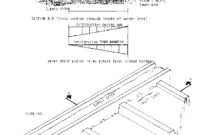With the border irrigation method, land is laid out with side berms running downhill on a slight slope. The land is levelled between side berms to make the irrigation water run in a narrow sheet from the upper to the lower end of the field. When irrigation starts, the infiltration rate is high at the upper end of the border but, as the soil becomes saturated, the leading edge of the water continues to move downhill. Its rate of forward movement depends on soil type, slope, and quantity of water released. To provide enough water at the lower end of the field without over watering the upper end, a high berm is constructed at the lower end to hold back a pool of water to irrigate the lower end after the supply is cut off.
Determining the correct length and slope of a border system is by trial-and-error, depending upon the factors listed above; however a good starting point can be made as follows.
Lay out the border strip so the lower end is lower than the upper end by about the average amount of irrigation water to be applied in one irrigation.
When the irrigation water has progressed to about 80 percent of the length of the border, cut off the irrigation water and let the residue pond to the lower end. The water that ponds should irrigate the lower end of the border.
The two infiltration rates should provide water over the full length of the border strip. Distributing water uniformly across the width of the border strip requires that the level of the soil be very flat (level) across the width of the border. If the border is very wide, water should be supplied at more than one point from the distribution channel.
Obviously the level of water in the distribution channel must be above the level of the land at the upper end of the border. That is, the channel must not be in an excavated area but must be contained between berms. The berms may be formed from excess earth taken from the channel between the water source and the field or from some area not to be irrigated.

The water’s level may be raised at the head of the border by placing a small dam across the distribution channel just downstream from the border. This temporary dam may be earthen, a sheet metal dam inserted into the bottom and sides of the channel, or a plastic sheet dam.
The plastic sheet dam is made by rolling several turns of plastic around a wooden pole. The pole is then laid across the channel berms and the sheet laid upstream along the bottom and sides of the channel for a meter or two. The pressure of the water holds the sheet against the bottom and sides tightly enough to prevent leakage.
Leveling across the border will usually be required. It may be done with shovels or other hand tools.
